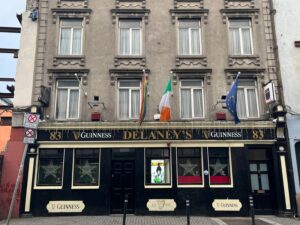 While Dublin city centre certainly has plenty of pubs, we are fortunate in also having additional parts of town that are also jam-packed with excellent options, especially when the holidays can make those in the immediate centre more crowded than usual. Smithfield and Stoneybatter are particularly blessed with not only a large number of pubs, but pubs that all have their own individual character – there’s cosy vibes with craft beer and pizza at Bonobo, or fantastic food and local colour at L. Mulligan. Grocer, plus all the trad music you could wish for at The Cobblestone – and that’s name-checking only a few of the many options.
While Dublin city centre certainly has plenty of pubs, we are fortunate in also having additional parts of town that are also jam-packed with excellent options, especially when the holidays can make those in the immediate centre more crowded than usual. Smithfield and Stoneybatter are particularly blessed with not only a large number of pubs, but pubs that all have their own individual character – there’s cosy vibes with craft beer and pizza at Bonobo, or fantastic food and local colour at L. Mulligan. Grocer, plus all the trad music you could wish for at The Cobblestone – and that’s name-checking only a few of the many options.
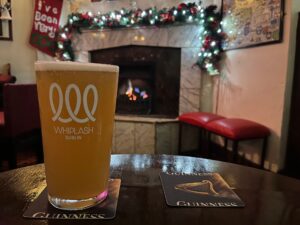 So, it’s taken us a while to get to Delaney’s, which has very much a ‘pubby’ pub feel, but it was worth the wait. There’s a wonderful fireplace for our current season, and a large back garden for less-chilly temperatures (though it is also heated); it is truly a pub that caters to the ever-changing weather – just mind the suit of armour by the back door. While the building was built as a house around 1800, it’s been a pub since the 1880s, and it’s very much a family-run pub.
So, it’s taken us a while to get to Delaney’s, which has very much a ‘pubby’ pub feel, but it was worth the wait. There’s a wonderful fireplace for our current season, and a large back garden for less-chilly temperatures (though it is also heated); it is truly a pub that caters to the ever-changing weather – just mind the suit of armour by the back door. While the building was built as a house around 1800, it’s been a pub since the 1880s, and it’s very much a family-run pub.
Indeed, it has the kind of ‘neighbourhood pub’ feel you get in many places around town. Delaney’s doesn’t have the slightly-faded grandeur of some of the high Victorian pubs like The Long Hall or The Hut, but it has a warm welcome and plenty of books for those chill solo pints. Local independent beer is represented by Whiplash and Trouble, and there’s food if you’re peckish, too. There is the customary Guinness, but also Beamish, Harp and Heineken/Beavertown’s Neck Oil, whose ubiquity in Dublin seems to be increasing in inverse proportion to its quality…but here we are, that’s on Heineken, not the pub.
Granted, this is not a spot that you’ll be bringing the kids, but there are plenty of other places around nearby that do welcome them; if you’re on the hunt for an afternoon or evening out alone or with your fellow grownups, you can catch the sport or relax with a local pint at Delaney’s.
Where: 83 King St N, Smithfield, Dublin 7, D07 PF51
Access from the city centre: Buses 23, 24, 37, 39, 39A, 70, Luas Red Line, 27ish minute walk
Food: Pub grub
Sport: Sports galore
TVs: All around
Music: Classic rock vibes
Family-friendliness: No kids here
Pub-crawl-ability: High – The Cobblestone, Bonobo and The King’s Inn are all in the immediate area, with Walsh’s, The Belfry, L. Mulligan. Grocer, Hynes’ Bar, The Barber’s Bar and The Glimmer Man in Stoneybatter, and Fidelity and Frank Ryan’s not much further on…plus, all of Capel Street, too…
Local sites of note: Lighthouse Cinema, Jameson Distillery, St Michan’s Church, TUD Grangegorman
Haunted: The suit of armour looks far too recent to be haunted
Other notes: Main floor toilets
Socials: Instagram

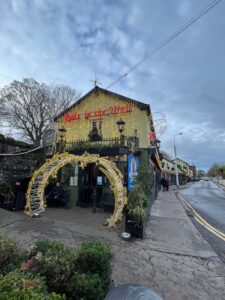 Staying on
Staying on 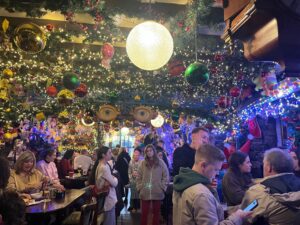 Inside, it can be absolutely packed at this time of year, both with decorations (similar to
Inside, it can be absolutely packed at this time of year, both with decorations (similar to  But The Hole in the Wall is a pub for life, not just for Christmas – there are also running and cycling clubs based here, and it’s a handy spot if you happen to be on this side of the Phoenix Park (though you’d have
But The Hole in the Wall is a pub for life, not just for Christmas – there are also running and cycling clubs based here, and it’s a handy spot if you happen to be on this side of the Phoenix Park (though you’d have 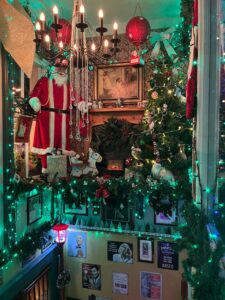 And while the two clear front-runners in the Most Extra for Christmas race are
And while the two clear front-runners in the Most Extra for Christmas race are 

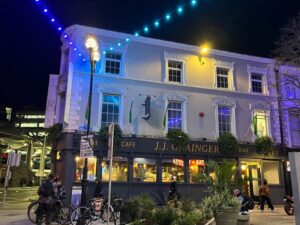 Dublin – indeed, Ireland – is not over-endowed with glorious (or even ‘fine’) train stations. Having recently
Dublin – indeed, Ireland – is not over-endowed with glorious (or even ‘fine’) train stations. Having recently 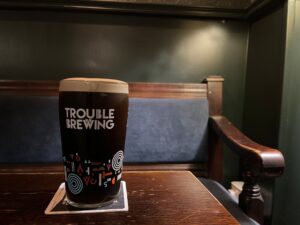
 The staff were also friendly and welcoming – how many pubs would put on the ‘Airwolf’ theme when asked to do so (not, it must be said, by us, but we did enjoy it)? And while it’s true that this part of Dublin still has a bit of a ‘reputation,’ something we’ve discussed in our entry on
The staff were also friendly and welcoming – how many pubs would put on the ‘Airwolf’ theme when asked to do so (not, it must be said, by us, but we did enjoy it)? And while it’s true that this part of Dublin still has a bit of a ‘reputation,’ something we’ve discussed in our entry on 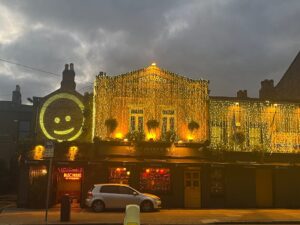 We’ll say up front that we are very much not night owls.
We’ll say up front that we are very much not night owls.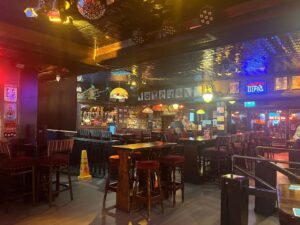
 It’s once again worth stating, though, that it’s entirely possible that we’re not the target demographic, and that the real action begins after, say, 9 pm…by which point, we’re generally in pajamas. In this particular instance, we wanted to continue to celebrate the footy win, and so hopped back across the street to
It’s once again worth stating, though, that it’s entirely possible that we’re not the target demographic, and that the real action begins after, say, 9 pm…by which point, we’re generally in pajamas. In this particular instance, we wanted to continue to celebrate the footy win, and so hopped back across the street to 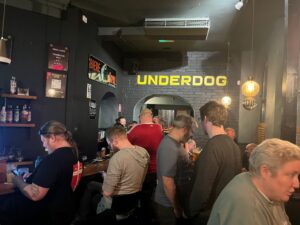 What happens when your favourite pub closes?
What happens when your favourite pub closes?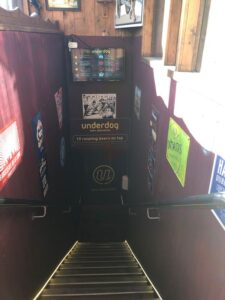 Covid lockdowns notwithstanding (and even then, there were occasions where it was possible to pop in to pick up some cans), I have never known an Underdog-free Dublin. Yes, that’s a reminder of my blow-in status, but it was one of the first local pubs I ever visited, long before moving here, as well as the last before lockdown started, just after we arrived permanently. In those days, Underdog was in the basement of Brogan’s; the damp from neighbouring Dublin Castle’s moat made things moist at times. But there were good memories from that location, most notably, the working beer engine on Fridays, and incredibly friendly regulars. The beer was a fantastic mix of interesting beers from all across Ireland, as well as choices from the UK, the US and elsewhere in Europe. The bottles and cans were just as diverse as the options on tap, and the knowledgeable crowd would happily make recommendations to visitors or newbies. I quickly got to know Paddy, the owner and all-around legend, and always felt warmly welcomed.
Covid lockdowns notwithstanding (and even then, there were occasions where it was possible to pop in to pick up some cans), I have never known an Underdog-free Dublin. Yes, that’s a reminder of my blow-in status, but it was one of the first local pubs I ever visited, long before moving here, as well as the last before lockdown started, just after we arrived permanently. In those days, Underdog was in the basement of Brogan’s; the damp from neighbouring Dublin Castle’s moat made things moist at times. But there were good memories from that location, most notably, the working beer engine on Fridays, and incredibly friendly regulars. The beer was a fantastic mix of interesting beers from all across Ireland, as well as choices from the UK, the US and elsewhere in Europe. The bottles and cans were just as diverse as the options on tap, and the knowledgeable crowd would happily make recommendations to visitors or newbies. I quickly got to know Paddy, the owner and all-around legend, and always felt warmly welcomed.
 We still have no firm answer to that question, but it’s fair to say we made the most of the last few weeks of business; there would be no kegs left for any potential new owners to have to worry about. We brought in bottles and cans from all over the world to share as the taps ran out, and made sure that we put in extra orders at the excellent Boco Pizza across the street. From leftover Mexican-ish lager to Westvleteren 12 (and everything in between), it was all shared and, mostly, enjoyed. There were hugs, some tears and a lot of laughter on the final night.
We still have no firm answer to that question, but it’s fair to say we made the most of the last few weeks of business; there would be no kegs left for any potential new owners to have to worry about. We brought in bottles and cans from all over the world to share as the taps ran out, and made sure that we put in extra orders at the excellent Boco Pizza across the street. From leftover Mexican-ish lager to Westvleteren 12 (and everything in between), it was all shared and, mostly, enjoyed. There were hugs, some tears and a lot of laughter on the final night.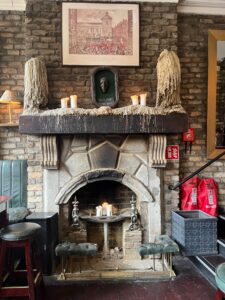 There’s a definite chill in the air, and a quick search on any platform will turn up a number of lists for cosy
There’s a definite chill in the air, and a quick search on any platform will turn up a number of lists for cosy  Our absolute favourites, though, are almost hidden gems when it comes to a roaring fire, and are well worth seeking out.
Our absolute favourites, though, are almost hidden gems when it comes to a roaring fire, and are well worth seeking out.  We’ve not always been fair to
We’ve not always been fair to  The first point in its favour – for us, anyway – is its support for local independent beer: there are multiple
The first point in its favour – for us, anyway – is its support for local independent beer: there are multiple  While it’s true that when in this general direction we are more often to be found at
While it’s true that when in this general direction we are more often to be found at  While
While 
 And it is, perhaps, fitting that Neary’s is a pub that attracts this kind of lore; its beautifully-maintained interior hearkens back to the 1880s – well, at least in the main bar downstairs – while upstairs, it’s a slightly more updated restaurant feel, but still elegantly understated. The
And it is, perhaps, fitting that Neary’s is a pub that attracts this kind of lore; its beautifully-maintained interior hearkens back to the 1880s – well, at least in the main bar downstairs – while upstairs, it’s a slightly more updated restaurant feel, but still elegantly understated. The  On our perambulations around Dublin this week, we visit what feels like a proper dive bar…that is, assuming proper dive bars all have a few good local taps and a killer playlist. If so, then Anseo is, indeed, in that category. But its slightly-scrubby-yet-cheerful interior doesn’t entirely hide the building’s history: this is a mid-18th century house, complete with a few extant interior features, that’s been repurposed as a pub since the mid-19th century. If you
On our perambulations around Dublin this week, we visit what feels like a proper dive bar…that is, assuming proper dive bars all have a few good local taps and a killer playlist. If so, then Anseo is, indeed, in that category. But its slightly-scrubby-yet-cheerful interior doesn’t entirely hide the building’s history: this is a mid-18th century house, complete with a few extant interior features, that’s been repurposed as a pub since the mid-19th century. If you  You are most likely to be visiting Anseo to catch a gig from an up-and-coming band or artist, or, perhaps, seeing some stand-up comedy upstairs; you may also be doing a
You are most likely to be visiting Anseo to catch a gig from an up-and-coming band or artist, or, perhaps, seeing some stand-up comedy upstairs; you may also be doing a 